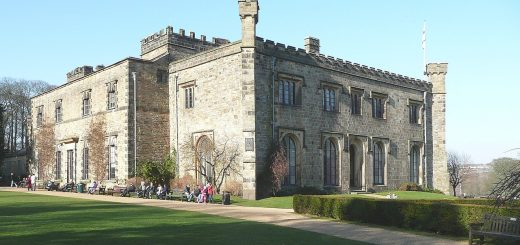Llech Lafar, St Davids
Llech Lafar, a speaking slab of marble by the River Alun is referred to by Wirt Sykes in his ‘British Goblins’ (1881). ‘The Talking Stone Llechlafar, or stone of loquacity, served as a bridge over the river Alyn, bounding the churchyard of St. David s in Pembrokeshire, on the northern side. It was a marble slab worn smooth by the tread of many feet, and was ten feet long, six feet broad, and one foot thick. Ancient tradition relates that one day when a corpse was being carried over it for interment the stone broke forth into speech, and by the effort cracked in the middle, which fissure is still visible; and on account of this barbarous and ancient superstition the corpses are no longer brought over it.’
There is an later story relating to Llech Lafar told by Gerald of Wales (Born c 1146 – Died c 1223) and involving King Henry II, to whom he was a royal clerk and chaplin of from 1184.
St David’s cathedral was founded in honour of Saint Andrew the Apostle. The place where it stands is called the Valley of Roses. A better name for it would be the Valley of Marble, for it is in no sense rosy or remarkable for roses, whereas there are plenty of rocks all over the place. The churchyard is bounded on the north side by the River Alun, a muddy and unproductive stream. It runs under the Llech Lafar Stone, a slab of marble polished by the feet of those innumerable people who have walked across it. I have written about the size, texture and name of this stone in my Vaticinal History. What follows is my description of how Henry II, King of the English, crossed over this stone on his return from Ireland, as he went into the cathedral of Saint Andrew and Saint David to pray…….Dressed as a pilgrim, on foot and leaning on a staff, he went to pray in Saint David’s Cathedral. As he came to the white gate, he met a procession of church canons, who received him with due honour and reverence.
As the procession advanced, the clergy walking one by one with proper ceremony, a Welsh woman threw herslef at the King’s feet and made a complaint about the Bishop of St David’s. This was explained to the King by interpreter. Nothing could be done there and then about her petition, so she gestured violently with her hands and, with everyone listening, had the impudence to shout in a loud voice: “Revenge us today, Llech Lafar! Revenge the whole Welsh people on this man!” She was held back and driven away by those who understood the Welsh language. As she went she shouted even more loudly and violently. She repeated the well-known fiction and prophecy of Merlin, so often heard, that a King of England, who had just conquered Ireland, would be wounded in that country by a man with a red hand, and then, on his return to St David’s would die as he walked over Llech Lafar. This was the name of the stone which served as a bridge over the River Alun, the stream which marks the boundary of the cemetery on the north side of the cathedral……..It so happened that the King knew of this prophecy. When he reached the stone he stopped and eyed it closely. Then, without further hesitation, he walked boldly over it. As soon as he was across he turned, glared at the stone and with no small indignation made this trenchant remark about the soothsayer: “Merlin was a liar. Who will trust him now?’ A wit, who was there amongst the crowd, heard the King’s remark, and pretended to take umbrage at the insult to the prophet. “You are not the king who is to conquer Ireland” he said. “Merlin was not talking about you at all.”
Gerald of Wales was nominated several times to be Bishop of St David’s but this was blocked by Hubert Walter, Archbishop of Canterbury. Gerald is thought to be buried at St David’s Cathedral.




Recent Comments